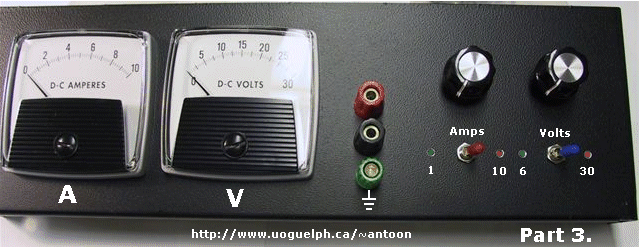

 Where applicable, click on the picture for
enlargements. Above you see the photo of my finished model. Looks good,
performance is excellent, and I am very happy with it. Notice however that the
panel meters are shown non-modified, meaning that I added and modified the
stripes for the two settings after the picture was taken.
Where applicable, click on the picture for
enlargements. Above you see the photo of my finished model. Looks good,
performance is excellent, and I am very happy with it. Notice however that the
panel meters are shown non-modified, meaning that I added and modified the
stripes for the two settings after the picture was taken.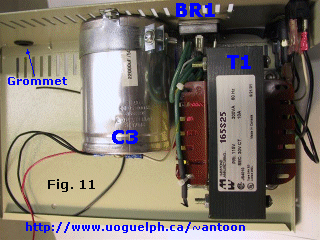 In case of a short circuit, there is at least 2.5
amps of current going through each power transistor, and that is a lot at about
60 to 70 watts of dissipating energy. That is why the 2N3772 power transistors
come in which can dissipate 350 watts or so. And so, as a matter of speaking, at
30 volts we could well assured short out the output jacks and fry an egg on the
output power transistors.
In case of a short circuit, there is at least 2.5
amps of current going through each power transistor, and that is a lot at about
60 to 70 watts of dissipating energy. That is why the 2N3772 power transistors
come in which can dissipate 350 watts or so. And so, as a matter of speaking, at
30 volts we could well assured short out the output jacks and fry an egg on the
output power transistors.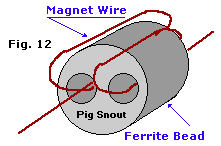 I call the ferrite beads "pig snouts" because that's what
it looks like to me, but hey, call it whatever you want. You need to make two of
them. On the circuit diagram they are indicated as L1 and L2. One or two turns
of thick magnet wire will do the trick.
I call the ferrite beads "pig snouts" because that's what
it looks like to me, but hey, call it whatever you want. You need to make two of
them. On the circuit diagram they are indicated as L1 and L2. One or two turns
of thick magnet wire will do the trick.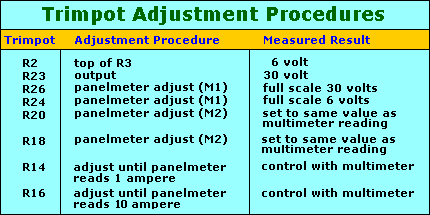 Don't worry about the current meter at this time,
it probably will not move at all because there is no current. All you do at this
time is adjusting the low-voltage scale.
Don't worry about the current meter at this time,
it probably will not move at all because there is no current. All you do at this
time is adjusting the low-voltage scale.| R1 = 470 ohm, 1/2 watt,
yellow-purple-brown R2 = 2 K, trimmer pot R3 = 5 K, potentiometer, linear R4 = 560 ohm R5 = 47 ohm, yellow-purple-black R6 = 0.1 ohm, ww, 5%, 1-watt (see text) R7 = 0.1 ohm, ww, 5%, 1-watt (see text) R8 = 0.1 ohm, ww, 5%, 1-watt (see text) R9 = 0.1 ohm, ww, 5%, 1-watt (see text) R10 = 0.33 ohm, ww, 5%, 10-watt R11 = 0.33 ohm, ww, 5%, 10-watt R12 = 470 ohm, potentiometer, linear R13 = 820 ohm, gray-red-brown R14 = 500 ohm, trimmer pot R15 = 150 ohm, brown-green-brown R16 = 100 ohm, trim pot R17 = See Text R18 = See Text R19 = See Text R20 = See Text R21 = 5K, metalfilm, 1% R22 = 820 ohm, gray-red-brown R23 = 500 ohm, trimmer pot R24 = See Text (non-variable: 25K trim pot) R25 = See Text (omit for non-variable voltage) R26 = See Text R27 = See Text R28 = 3.3K, 1/2 watt, 5%, orange-orange-red R29 = 3.3K, 1/2 watt, 5%, orange-orange-red R30 = 3.3K, 1/2 watt, 5%, orange-orange-red R31 = 3.3K, 1/2 watt, 5%, orange-orange-red Capacitors C1 = 3.3 nF, ceramic C2 = 3.3 nF, ceramic C3 = 15000 µF or higher, 45V+, electrolytic C4 = 1000 µF, 63V, electrolytic |
C5 = 4.7 µF, 25V, tantalum, or high-quality
electrolytic C6 = 4.7 µF, 25V, tantalum, or high-quality electrolytic C7 = 470pF, ceramic C8 = 10 µF, 63V, electrolytic C9 = 1 µF, foil type. see text C10 = 22 nF, ceramic Semiconductors D1 = 1N4004, 1N4005, 1N4007, BY127, etc. D2 = 1N4148, BAX13, BAX16, etc. D3 = 1N4389 power diode, 20A+ (see text) D5,D6,D7,D8 = Leds, any type (see text) ZD1 = 1N4754A, Zenerdiode, 1 watt, 39V ZD2 = 1N4636A, Zener, 250mW, 6.2 or 6.8V Q1 = TIP140, MJ2501, BD267A, 2N6388, etc. Q2,Q3,Q4,Q5 = Transistor, 2N3772/NTE181 L1,L2 = Ferrite Bead (click here for more info) IC1 = MC723, µA723, LM723 BR1 = Bridge Rectifier (see text) Miscellaneous M1 - Panelmeter, see text M2 - Panelmeter, see text T1 - Transformer, Hammond 165S25 (25V/10A), or similar  F1 = Fuse, 3.15A, slow-blow S1 = Toggle switch, ON-OFF, DPDT, sub-mini S2a-b = Toggle switch, ON-OFF-ON, DPDT S3a-b = Toggle switch, ON-OFF-ON, DPDT S4 = For use with one panelmeter: ON-OFF-ON, DPDT Fuseholder, very large coolrib for the 4 power transistors, Q1, and D3 (isolated), wire, solder, 2 knobs, instrument case, power cord, etc. The meter scales are re-scaled with rub-on lettering. |
Possible Component Substitutes: D1 = 1N4004, 1N4005, 1N4007, BY127, NTE116, NTE125 D2 = 1N4148, BAX13, BAX16, NTE519 D3 = Possible types: MUR2510, MUR3010CT, NTE6246, NTE6247, etc. ZD1 = 1N4754A, NTE5086A, ECG5086A ZD2 = 1N4736A, NTE5071A Q1 = BD267A, TIP140, MJ2501, NTE263, NTE270 Q2 = NTE181 IC1 = µA723, LM723, NE723, NTE923D
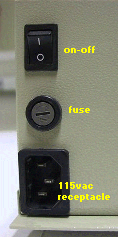 Last Minute changes and
other info:
Last Minute changes and
other info: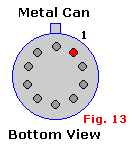 - If you decide to use the older 'metal-can' version of the
723, the pin out is shown at the left.
- If you decide to use the older 'metal-can' version of the
723, the pin out is shown at the left.